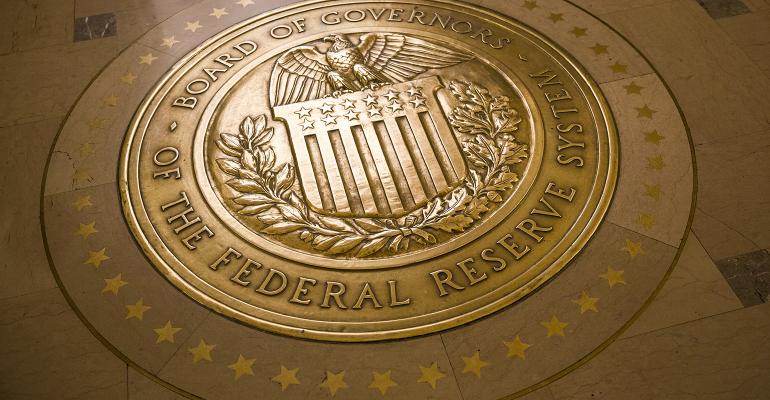By Christopher Condon
(Bloomberg) -- The Federal Reserve reduced interest rates for the first time since the financial crisis and hinted it may cut again this year to insulate the record-long U.S. economic expansion from slowing global growth.
Central bankers voted, with two officials dissenting, to lower the target range for the benchmark rate by a quarter-percentage point to 2%-2.25%. The shift was predicted by most investors and economists, yet will disappoint President Donald Trump, who tweeted on Tuesday he wanted a “large cut.’’
“In light of the implications of global developments for the economic outlook as well as muted inflation pressures, the committee decided to lower’’ rates, the Federal Open Market Committee, led by Jerome Powell, said in a statement following a two-day meeting in Washington. It also noted that “uncertainties” about the economic outlook remain.
U.S. stocks whipsawed between gains and losses after the Fed’s announcement, while Treasuries and the dollar also fluctuated as traders awaited Powell’s press conference.
Officials also stopped shrinking the Fed’s balance sheet effective Aug. 1, ending a process that very modestly tightens monetary policy and was previously scheduled to come to a close at the end of September.
Policy makers appeared open to another cut as early as September when they next convene, while sticking with wording in their statement that preserves their options.
“As the committee contemplates the future path of the target range for the federal funds rate, it will continue to monitor the implications of incoming information for the economic outlook and will act as appropriate to sustain the expansion,” they said.
Kansas City Fed President Esther George and Boston’s Eric Rosengren voted against the cut. The statement said they “preferred at this meeting to maintain the target range for the federal funds rate.” It was the first time since Powell took over as chairman in February 2018 that two policy makers dissented.
Investors had forecast the Fed to continue easing monetary policy this year, with futures pricing the key rate to fall about another half-point by January. U.S. stocks rose to a record last week in anticipation of easier money, while the yield on two-year Treasuries has undershot 2% since May.
Powell will hold a press conference at 2:30 p.m., with investors eager for clues on how much lower the Fed will go.
While the domestic economy has performed relatively well, the Fed cut amid concern that softness abroad threatens the decade- long U.S. expansion. Trump’s trade war with China is hurting foreign demand. Data released earlier Wednesday showed the pace of quarter-over-quarter growth in the euro area slowed by half in the latest three months to 0.2%.
In the U.S., after growing 2.5% last year, fueled by now-fading tax cuts and higher government spending, the economy expanded at a 2.1% annualized pace in the second quarter. The trade dispute was blamed for a manufacturing slowdown and the first drop in business investment since 2016.
In their assessment of the U.S. economy, officials made only minor changes to their statement language.
Powell has repeatedly said the Fed’s “overarching goal’’ is to keep growth going. Acting now, when the central bank has less room to pare rates than in past downturns, is partly aimed at getting ahead of any potential slump.
Lackluster inflation also offered the Fed space and reason to ease. Its preferred price gauge, excluding food and energy, rose 1.6% in June from a year earlier and hasn’t met the Fed’s 2% target this year.
Trump is unlikely to be satisfied as he puts the economy at the heart of his re-election bid. He has broken with convention and undermined the Fed’s political independence by lobbying it to loosen policy and publicly questioning his nomination of Powell as chairman.
At his press conference, Powell will almost certainly be asked if the Fed buckled to that pressure. He may also be quizzed on whether the Fed, if requested, would join the U.S. Treasury in any effort to weaken the dollar given Trump’s complaints about the currency’s value.
What Our Economists Say
The statement did not provide clear direction regarding the timing or magnitude of additional cuts, thereby leaving policy makers some flexibility to respond accordingly to economic and financial market developments. Bloomberg Economics expects one additional 25 bps cut by year-end, but the FOMC does not appear particularly inclined to deliver this at the next meeting.
Click here for more
While Trump and some investors wanted the Fed to be more aggressive, its scope for doing so is limited. Stocks are high, unemployment is around the lowest in a half-century and consumers continue to spend. There’s also a chance lower rates will lead to asset bubbles and excessive borrowing that will haunt the economy later.
The rate reduction was the first since December 2008 when the Fed dropped its benchmark effectively to zero as it battled recession and financial crisis. It began raising borrowing costs in December 2015, doing so another eight times. Officials indicated as recently as December they intended to continue to hike this year.
They dumped that plan in January as financial markets fretted monetary policy had become too restrictive.
Fellow central banks are set to follow the Fed. Those in India, South Africa and Australia are among those to have cut this year. Brazil is set to cut later today and the European Central Bank has indicated it will do so in September.
A worry for policy makers is that a decade of easy money leaves them short of ammunition for fighting a serious downturn. That likely means governments will face demands to do more if economies keep struggling.
--With assistance from Jordan Yadoo, Ben Holland, Liz Capo McCormick and Emily Barrett.
To contact the reporter on this story:
Christopher Condon in Washington at [email protected]
To contact the editors responsible for this story:
Alister Bull at [email protected]
Scott Lanman, Jeff Kearns




